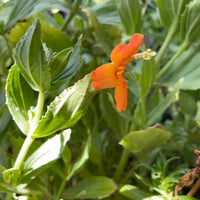

Mimulus cardinalis (scarlet monkeyflower)
Scarlet monkeyflower
A herbacious perennial in the lopseed family. It has orange-red flowers that bloom in the spring through fall and toothed, downy leaves. It is best to plant in dry shade, if grown in full sun they will turn brown and go dormant. It is typically found in wetlands or moist areas. It is a fairly large, spreading, plant that grows up to three feet wide and high. It is best to pinch regularly to help the plant establish a dense branching habit. It is important to establish a dense branching habit to support the upright branches flower stalks. You can remove the stalk after flowering. You can cut off all existing flower stalks in mid May through June if you would like a second flowering season! You can shape in the fall. If old wood is pruned new growth will not resprout.
Plant with: Seep Monkeyflower (Erythranthe guttata), Hedge Nettle (Stachy bullata), Blue Flax (Linum lewisii), Western Columbine (Aquilegia formosa), Douglas Iris (Iris douglasiana), and Stream Orchid (Epipactis gigantea).
- Plant in light shade (can take full sun but does not do as well)
- Tolerates Clay or sand texture
- Regular water
- Attracts hummingbirds, birds, and bees
- Deer resistant
- Native to California
This content type will accept rich text to help with adding styles and links to additional pages or content. Use this to add supplementary information to help your buyers.
You can use product metafields to assign content to this tab that is unique to an individual product. Use tabs to highlight unique features, sizing information, or other sales information.
Scarlet monkeyflower
A herbacious perennial in the lopseed family. It has orange-red flowers that bloom in the spring through fall and toothed, downy leaves. It is best to plant in dry shade, if grown in full sun they will turn brown and go dormant. It is typically found in wetlands or moist areas. It is a fairly large, spreading, plant that grows up to three feet wide and high. It is best to pinch regularly to help the plant establish a dense branching habit. It is important to establish a dense branching habit to support the upright branches flower stalks. You can remove the stalk after flowering. You can cut off all existing flower stalks in mid May through June if you would like a second flowering season! You can shape in the fall. If old wood is pruned new growth will not resprout.
Plant with: Seep Monkeyflower (Erythranthe guttata), Hedge Nettle (Stachy bullata), Blue Flax (Linum lewisii), Western Columbine (Aquilegia formosa), Douglas Iris (Iris douglasiana), and Stream Orchid (Epipactis gigantea).
- Plant in light shade (can take full sun but does not do as well)
- Tolerates Clay or sand texture
- Regular water
- Attracts hummingbirds, birds, and bees
- Deer resistant
- Native to California


